
Profile by Phil Crosby
Leopard
Panthera pardus
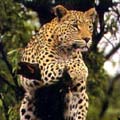 |
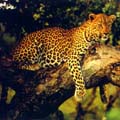 |
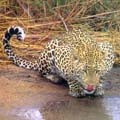 |
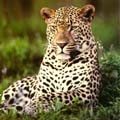 |
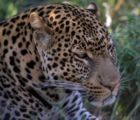 |
| Leopards photographed by Phil Crosby in Kenya | ||||
|---|---|---|---|---|
In their native Africa and Asia, Leopards are widespread but rarely seen. Stealthy and elusive, they are also surprisingly well camouflaged. The twitch of a tail may be the only give-away to a leopard resting in the branches of a tree. Black (melanistic) leopards occur in the wild only rarely, and it is unclear whether the reported instances of 'black panthers' in the UK are the result of inbreeding, or if the novelty of black leopards made them more popular as pets or in zoos, resulting in a greater incidence of melanism in escapees.
Life span
Leopards can live for 10-15 years in the wild, although in captivity they can live for up to 20 years.
Statistics
Body length: 95-167 cm, Tail length: 60-97 cm, Shoulder height: 50-75 cm, Weight: 30-80 kg. There can be considerable variation in size depending on location. Mountain leopards are smaller than their savannah counterparts because prey is smaller in the mountains. Particularly large individuals of over 95 kg have been recorded in South Africa's Kruger National Park, where prey is larger. Generally males are 20-40 per cent larger than females.
Physical Description
Leopards typically are a light tan colour with a rosette-patterned coat and a long tail. They have a large skull and massive jaw muscles. Some leopards are completely black and are known as panthers. They can be born in the same litter as normally marked cats. Observations indicate that these are most generally found in dense forest areas of India and SE Asia where the dark coat offers an advantage in camouflage. Panthers are mostly found in the dense, wet forested areas of India and south east Asia.
The leopard is sometimes confused in appearance with the jaguar. Leopards are less stocky and have smaller rosette markings without internal spots. The base coloration of the coat varies depending on location.
Distribution
The leopard has the most widespread distribution of all the cats and can be found in India, Africa, China, Siberia and Korea.
Habitat
Leopards are generalist predators and are able to live in any habitat where there is sufficient cover and prey, including open savannah, forests, jungles, cold mountainous regions and even on the outskirts of urban areas.
Diet
They have a number of prey items, including gazelles, antelopes, monkeys, jackals, duiker, eland, impala, insects, wildebeest, rodents, hyraxes, hares, peacocks, snakes, sheep and goats. Leopards can live independently of water for long periods of time, obtaining liquid from their prey.
Behaviour
Leopards lead a solitary lifestyle. Males inhabit territories of 5 to 40 square km, which may overlap with the territories of several females. They are very defensive of their territory and urinate around the boundaries of their territories to warn off intruders. They are most active between sunset and sunrise.
Leopards in Africa often take their kills up into the safety of tree branches, to avoid the attention of hyenas and lions. They are incredibly strong and are capable of lifting carcasses three times their own body weight, placing them on branches over 6m high. There have been several reports of leopards hauling young giraffes into trees. (Note, studies show that this is a direct response to competition from other predators. As such, it is likely that this behaviour would be far less common in the UK).
 |
 |
 |
| Return to index | Return to Scottish Big Cats | Return to Identification |